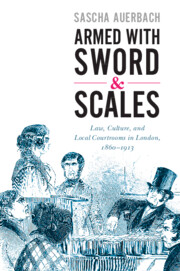Book contents
- Armed with Swords & Scales
- Studies in Legal History
- Armed with Swords & Scales
- Copyright page
- Dedication
- Epigraph
- Contents
- Figures
- Acknowledgments
- Glossary of Terms and Abbreviations
- Introduction
- 1 “Many-Coloured Scenes of Life”
- 2 “A Ruffian Rightly Punished”
- 3 “An Evil Quarter of an Hour about the Precincts”
- 4 “Two Shillings’ Worth of Revenge in the Form of a Summons”
- 5 A Poor Woman’s Court of Justice, 1882–1910
- 6 “The Very Centre of Observation and Information”
- Conclusion
- Bibliography
- Printed Primary Sources
- Secondary Sources
- Index
5 - A Poor Woman’s Court of Justice, 1882–1910
Published online by Cambridge University Press: 05 February 2021
- Armed with Swords & Scales
- Studies in Legal History
- Armed with Swords & Scales
- Copyright page
- Dedication
- Epigraph
- Contents
- Figures
- Acknowledgments
- Glossary of Terms and Abbreviations
- Introduction
- 1 “Many-Coloured Scenes of Life”
- 2 “A Ruffian Rightly Punished”
- 3 “An Evil Quarter of an Hour about the Precincts”
- 4 “Two Shillings’ Worth of Revenge in the Form of a Summons”
- 5 A Poor Woman’s Court of Justice, 1882–1910
- 6 “The Very Centre of Observation and Information”
- Conclusion
- Bibliography
- Printed Primary Sources
- Secondary Sources
- Index
Summary
Chapter 5 examines how, via the daily parade of summonses, a variety of actors employed local courtrooms to shape the social and cultural contours of marriage and affiliation. As in other aspects of metropolitan life, the courtroom was not merely a venue for the expression of law or norms that were constituted elsewhere or a space for the enforcement of middle-class standards of morality. Legal structures originally developed to protect patriarchal privilege could, to some degree, be co-opted by women instead. Several decades before working-class women could directly shape the terrain of formal politics, they were effectively navigating the terrain of local courtrooms and influencing both their daily practices and the meanings that emerged from them. Their engagement demonstrates how crucial working-class women were to recasting the nature of the state in this period. The adaption of the state to address familial matters occurred in tandem with the adaption of women to the mechanisms of the state.
- Type
- Chapter
- Information
- Armed with Sword and ScalesLaw, Culture, and Local Courtrooms in London, 1860–1913, pp. 218 - 280Publisher: Cambridge University PressPrint publication year: 2021

